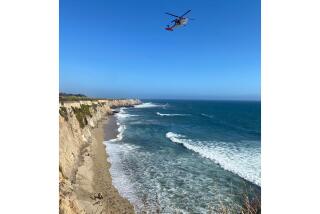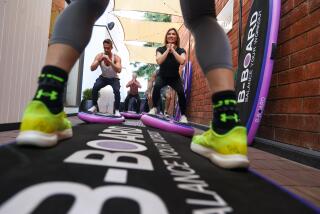Skip the School, Pay the Price : Lessons Are Imperative for the Novice Windsurfer Who Doesn’t Want to Wind Up All Wet
- Share via
Standing on a grassy knoll overlooking Ventura Harbor, windsurfing instructor Dorothy Bacchilega watched a teen-age boy do a poor imitation of a real windsurfer: When he wasn’t falling off the board by accident, he was doing it intentionally--to avoid a collision with another craft.
Bacchilega studied the boy’s technique. Legs twisted, arms wrapped around the mast, he looked like a drunk hanging on to a light pole. “He’s doing everything wrong,” Bacchilega said.
Whoooops. He capsized again, allowing the sail to fall on top of him like a shroud and pin him underwater for a few uncertain moments.
The boy was not one of Bacchilega’s students--nor, apparently, anybody else’s. Judging by his obvious lack of skills, it was doubtful whether his knowledge of windsurfing consisted of more than two minutes of pointers from the owner of the sailboard.
“Lessons are imperative,” Santa Barbara instructor Jessica Gibassier said.
The rule of thumb on deciding whether to take a lesson: Do it if your IQ is higher than the water temperature. Lessons might cost money and take time but are considerably easier and safer than learning on your own.
Learning the fundamentals takes only six to eight hours, half the time spent on land and the other half on the water. Lessons generally cost less than $100 and include use of a sailboard and a wet suit. Two-hour introductory lessons are usually also available for less money.
“Women learn quicker than men,” said Frank Bacchilega, Dorothy’s husband and fellow teacher. “Guys think they’re athletes and they take for granted they can do it. Their attitude is that it’s easy.”
On land, instructors use a simulator--a real sailboard held by a swivel device, allowing the sailboard to react with the wind. Balancing on the board, a student can practice all the right moves without getting wet.
“You don’t have to be an athlete to learn to windsurf,” Frank said. “But you do have to be able to listen and follow instructions.”
Learning the basic position--knees slightly bent, head high, rig 90 degrees to board--is just a matter of repetition, like memorizing a dance step. But applying the lessons on the water is another story. Suddenly, your legs, so steady on the simulator, feel like rubber.
The real trick to windsurfing is becoming a sailor, mastering the wind and reacting instinctively to changing conditions, but on the water a student at first can’t even make his feet move, let alone figure out the nuances of steering.
By the end of the lesson, a student usually has decided whether windsurfing will become a habit. Half-hearted windsurfers wind up renting sailboards, for about $10 an hour, or buying a used board for $300. Those who get serious face months of hard work to become proficient enough to plane--getting the board on its edge to maximize lift and literally converting the sailboard into a wing capable of gliding for miles over the open sea.
At that point, a windsurfer usually goes off the deep end, often changing lifestyles to accommodate the sport. Hard-core windsurfers can spend a few thousand dollars for equipment and usually have to buy a van to haul all their gear. A good board can cost $2,800. Sails can run $500. Masts often break and replacements cost $200.
“If you get into it,” Frank said, “your quiver will probably consist of a shortboard and longboard, two masts, three sails and two sets of booms.”
Aficionados use different combinations of boards and sails depending on the wind and the waves. The longboards, weighing as much as 38 pounds and using a large sail, need less wind than a 20-pound shortboard and can move in breezes as light as 5 m.p.h.
Aside from becoming skillful sailors, windsurfers also have to learn the rules of boating, including right of way, and they have to coexist with surfers and sailors in sailboats and motorized craft.
“We try to teach you to stay out of the way of power boats,” Dorothy Bacchilega said.


